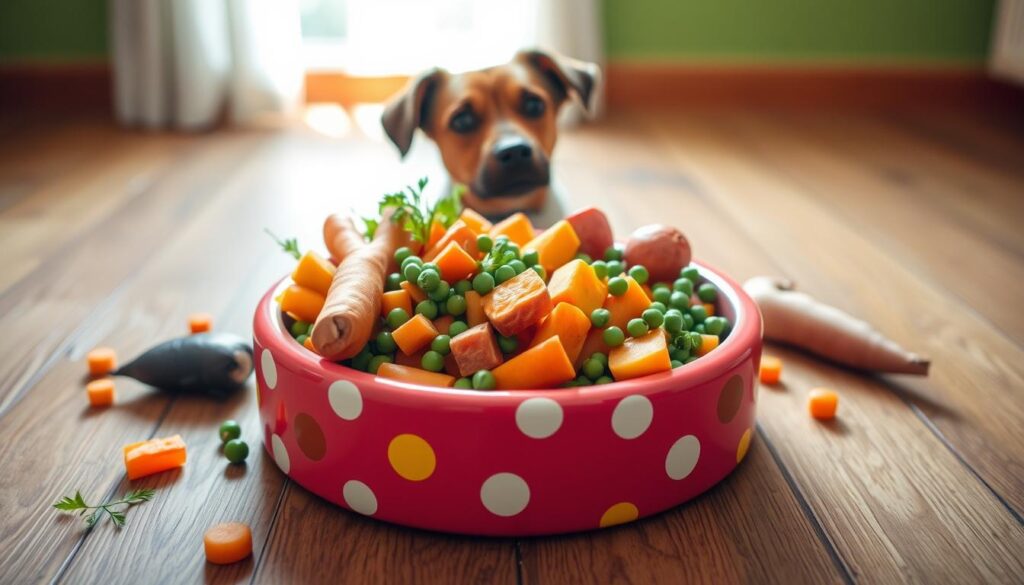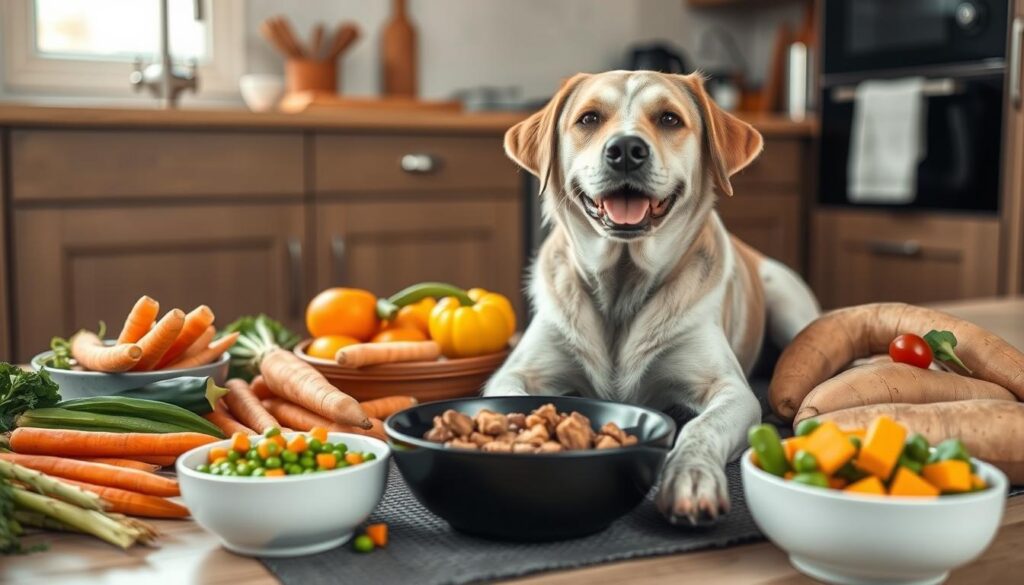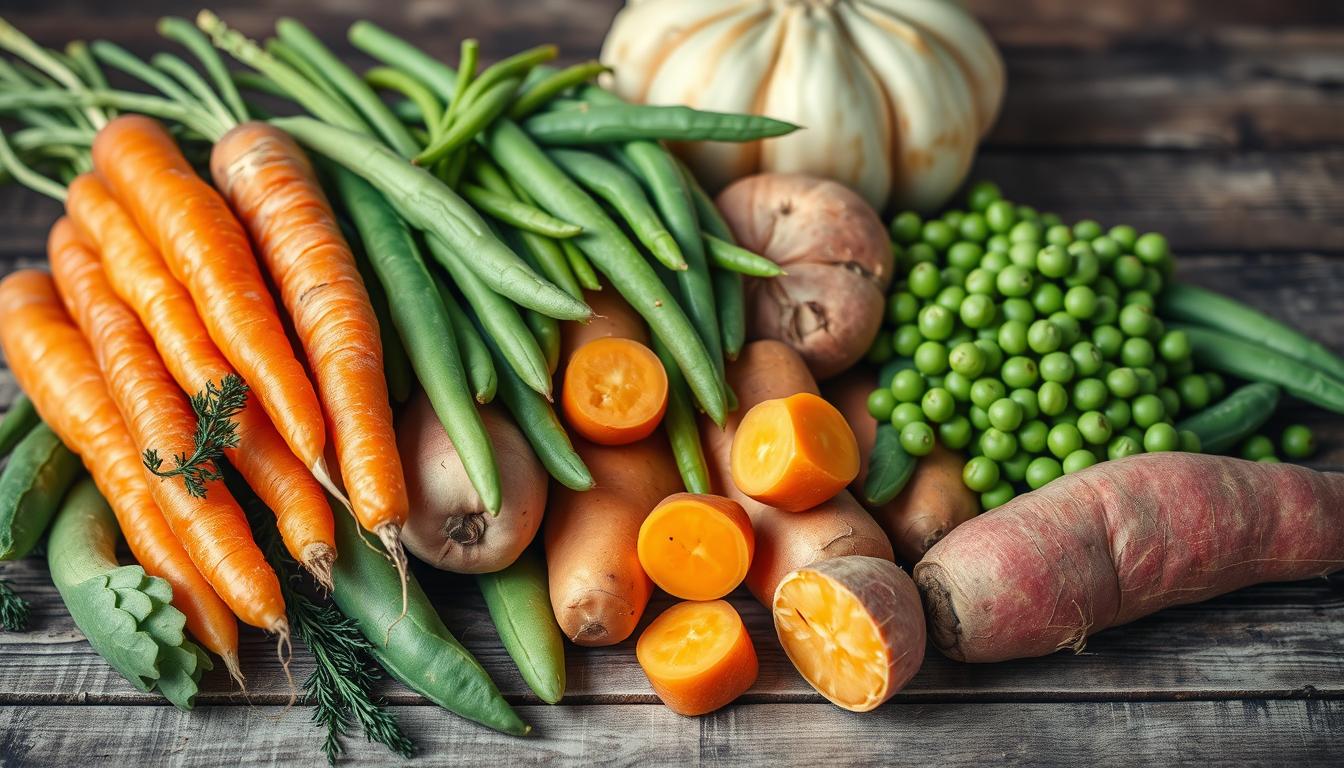As a devoted dog parent, you want the best for your furry friend. You know they need good nutrition for their health. Dogs can really benefit from eating certain vegetables. These foods are full of nutrients and can help with weight and immune health.
Finding the right vegetables for your dog can seem hard. But with the right help, you can add these healthy foods to their meals. This guide will show you the benefits, best vegetables, and how to prepare them safely for your dog.
Table of Contents
Benefits of Including Vegetables in Your Dog’s Diet
Adding vegetables to your dog’s meals can be very beneficial. They are low in calories but rich in fiber. This makes them great for weight management and digestive health.
The fiber in veggies helps keep your dog’s bowels regular. It also supports the health of their anal glands. This keeps your furry friend feeling good and healthy.
Vegetables also have antioxidants that boost your dog’s immune system. They help fight off sicknesses. Plus, colorful veggies like carrots can improve your dog’s eyes and brain.
Some veggies, like carrots, are perfect for low-calorie training rewards. They’re a smart choice for your dog’s diet.
Weight Management and Digestive Health
Vegetables are full of fiber, which is good for your dog’s digestion. The fiber helps keep their bowels regular. It also makes them feel full, which helps with weight management.
Immune System Support and Disease Prevention
Vegetables are full of antioxidants and nutrients that support your dog’s immune system. They help prevent diseases. Eating a variety of colorful veggies can keep your dog healthy, from fighting heart disease to reducing allergy and arthritis risks.
Training and Reward Options
Some veggies, like carrots, are great for training rewards because they’re low in calories. Raw, crunchy veggies also clean your dog’s teeth and can calm them down. They’re a great addition to your dog’s diet.
What Vegetables Can Dogs Eat?
Dogs can safely enjoy many safe vegetables for dogs. These veggies give them important nutrients and health benefits. Adding dog-friendly veggies to their diet can make them healthier and happier.
Some of the safe vegetables for dogs include:
- Pumpkin: High in fiber and vitamins A, B1, B6, and C, pumpkin can help with digestive issues.
- Broccoli: Rich in vitamins and minerals, broccoli supports immune system health.
- Carrots: Packed with beta-carotene, carrots are great for dental health and vision.
- Green Beans: A low-calorie option, green beans provide protein, fiber, and essential vitamins and minerals.
- Kale: This leafy green is a powerhouse of vitamins A, C, and K, as well as calcium and iron.
- Spinach: Spinach contains antioxidants and nutrients that promote healthy skin and a shiny coat.
- Brussels Sprouts: High in vitamins C and K, Brussels sprouts are also a good source of omega-3 fatty acids.
- Zucchini: Zucchini is low in calories and rich in vitamins C and B6, as well as manganese and potassium.
- Sweet Potatoes: These starchy vegetables are a great source of fiber, vitamin A, and complex carbohydrates.
- Peas: Peas are packed with vitamins, fiber, and protein, making them a nutritious dog-friendly veggie.
| Vegetable | Nutritional Benefits |
|---|---|
| Carrots | High in vitamin A, great for dental health, and low in calories. |
| Green Beans | High in fiber and vitamins, low in calories, can be served raw, steamed, or boiled. |
| Celery | Hydrating, rich in vitamins A, C, and K, and 95% water. |
| Brussels Sprouts | Rich in vitamin C and K, antioxidants, and omega-3 fatty acids, but may cause gas. |
When introducing new dog-friendly veggies to your canine’s diet, start with small amounts. Watch for any bad reactions. Remember, veggies should add to their diet, not replace it.
Safe Preparation Methods for Dog-Friendly Vegetables
Adding vegetables to your dog’s diet can be very beneficial. But, it’s important to prepare them safely. Let’s look at the best ways to prepare veggies for your furry friend.
Raw vs. Cooked Options
Dogs can eat veggies raw or cooked. Raw veggies like carrots clean their teeth and offer a fun crunch. Cooking veggies can make them easier to digest, especially for dogs with sensitive stomachs.
When cooking, avoid using oils, seasonings, or salt. These can harm your dog.
Proper Sizing and Cutting Techniques
Cutting veggies into the right size is key to prevent choking, especially in small dogs. Cut them into small pieces to ensure safety and ease of chewing.
Storage Guidelines
Storing veggies properly is important for freshness and safety. Keep them in the fridge and throw away leftovers after a few days. This keeps your dog’s meals fresh and healthy.
By following these safe preparation methods, you can add a variety of veggies to your dog’s diet. This provides them with important nutrients and supports their health and happiness.
Top Nutritious Vegetables for Dogs
There are many superfoods that are great for dogs. These veggies help with weight, digestion, and immunity. They are full of nutrients that benefit your furry friend.
Sweet potatoes are a top pick. They have vitamins A and C, which are good for health. Broccoli is also great, with lots of fiber and vitamin C. Carrots are good for your dog’s eyes with beta-carotene. Green beans are tasty and full of fiber, helping with weight.
Pumpkin is a superfood for dogs, helping with digestion. Kale and spinach are full of vitamins K and A. They offer many essential nutrients.
| Vegetable | Key Nutrients | Health Benefits |
|---|---|---|
| Sweet Potatoes | Vitamins A and C | Antioxidant and anti-inflammatory properties |
| Broccoli | Fiber, Vitamin C | Supports digestive and immune health |
| Carrots | Beta-carotene | Promotes eye health |
| Green Beans | Fiber, Low Calories | Aids weight management |
| Pumpkin | Fiber | Supports digestive function |
| Kale, Spinach | Vitamins K and A | Provides essential nutrients |
Adding these veggies to your dog’s diet is beneficial. They help with weight, digestion, and immunity. As best vegetables for dogs, healthy dog snacks, and canine superfoods, they keep your dog healthy and happy.
Vegetables to Avoid Feeding Your Dog
Many vegetables are good for dogs, but some are not. Some can even be harmful or even toxic to them.
Onions, garlic, chives, and leeks belong to a family that can harm dogs. They can cause anemia by damaging red blood cells. Wild mushrooms are also poisonous and should never be given to dogs.
Unripe tomatoes and tomato plants have a toxic compound called solanine. Corn on the cob can cause choking and blockages in the intestines.
Always check if a vegetable is safe for dogs before giving it to them. Talking to your vet is key to keeping your dog safe from toxic vegetables for dogs and dangerous foods for dogs. This helps keep their pet food safety in check.
It’s always safer to be cautious with your dog’s health. Knowing which vegetables to avoid feeding your dog helps keep their diet safe and healthy.
Incorporating Vegetables Into Your Dog’s Meal Plan
Adding vegetables to your dog’s diet can boost their health. But, it’s key to do it right. Start with small amounts and watch how your dog reacts.
Proper Serving Sizes
The right amount of veggies for your dog depends on their size. For a big dog, it’s a few tablespoons. Smaller dogs might just need a teaspoon or two. Always check with your vet for the exact amount.
Frequency Guidelines
Start slow with veggies in your dog’s diet. Begin with a small amount a few times a week. Then, you can add them to their daily homemade dog food or balanced canine diet. This helps their stomach adjust and avoids upset.
Mixing With Regular Food
Make sure to mix veggies with their regular food. This keeps their diet balanced and prevents any nutritional gaps. You can mix them in or offer as a treat, but watch the calories.
By following these tips, you can improve your dog’s health. Always talk to your vet to make sure you’re giving the best homemade dog food and balanced canine diet.

Signs of Vegetable Intolerance in Dogs
Many dog-friendly vegetables can be great for your dog’s diet. But, some dogs might not do well with them. If your dog shows signs of intolerance or allergy after trying a new veggie, stop using it and talk to your vet.
- Vomiting
- Diarrhea
- Excessive gas
- Abdominal pain
- Changes in appetite
- Skin irritation or itching
Start new foods slowly to avoid digestive upset or canine digestive issues. Watch how your dog reacts. If you see any bad pet health symptoms, stop the veggie. Your vet can help figure out what’s wrong and how to safely add veggies to your dog’s meals.
| Common Dog Food Allergies | Prevalence |
|---|---|
| Chicken | 10-20% |
| Beef | 8-15% |
| Dairy | 5-10% |
| Wheat | 4-8% |
| Soy | 3-6% |
| Eggs | 2-5% |
Dog food allergies are not as common as environmental allergies, affecting only 0.2% of dogs. But, some breeds like Labrador Retrievers, West Highland White Terriers, and Cocker Spaniels might be more likely to have food allergies and intolerances.
Special Dietary Considerations
Vegetables are great for dogs, but some health issues need special diets. Always talk to a vet before changing your dog’s food, especially if they have health problems.
Diabetic Dogs
Dogs with diabetes should avoid high-sugar veggies like carrots and sweet potatoes. These can raise blood sugar too much. Instead, give them low-glycemic veggies like green beans, broccoli, and cauliflower. These help keep their weight healthy and support their overall health.
Overweight Dogs
Overweight dogs can benefit from low-calorie, high-fiber veggies. Green beans, zucchini, and spinach are good choices. Remember, treats should not make up more than 10% of their calories to prevent weight gain.
Senior Dogs
Senior dogs have different needs as they age. They might do better with softer veggies like cooked sweet potatoes, butternut squash, or mashed pumpkin. These foods support their joints, brain, and overall health in their golden years.
Knowing your dog’s special dietary needs helps keep them healthy. Always check with a vet to make sure you’re giving them the right food. This ensures they get the best care for their health and happiness.

Conclusion
Adding vegetables to your dog’s diet can be very beneficial. It can help with digestion, weight control, and boost their immune system. This guide shows how to safely add healthy veggies to your dog’s meals.
It’s important to pick safe veggies, prepare them right, and add them slowly. Always talk to your vet, especially if your dog has special needs or health issues. Remember, veggies should only be 10% of their diet. The rest should be high-quality protein and other important nutrients.
By adding the right veggies to your dog’s food, you can improve their health and happiness. With some research and the right steps, you can give your dog a balanced diet. This diet will include tasty and nutritious veggies.

